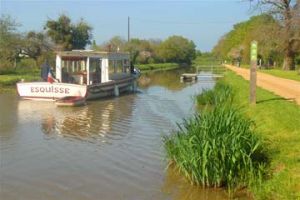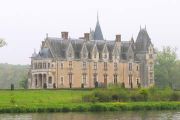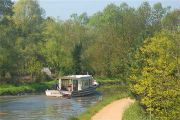 |

|
 Nantes to Brest Canal © T. Joly Nantes to Brest Canal © T. Joly

|
The Erdre and the Nantes to Brest canal go through beautiful landscapes passing by peaceful little towns, gorgeous castles and religious monuments. An historical and natural heritage you can discover by foot, by bicycle or by boat.
[ Practical ]
Getting there
- By road
380 km from Paris on autoroutes A6a and A10
- By train
TGV Paris Montparnasse – Nantes. The journey takes 2 h 10
Lodging
- Hotels
Auberge de la Forêt in Le Gavre
Hôtel de Bretagne in Nort-sur-Erdre
Le Relais de la Grange in Nort-sur-Erdre
- Bed and Breakfast
Le Nid d’Omer in Blain
Bernard Fourrage in Nort-sur-Erdre
Maryannick Raimonceau in Nort-sur-Erdre
Les Arbres Rouges in Sucé-sur-Erdre
Patricia Degrez in Sucé-sur-Erdre
Restaurants
Manoir de la Régate in Nantes
Clos Saint Thomas in Sucé-sur-Erdre
L’Escarpolette in Sucé-sur-Erdre
Chez Caline in Nort-sur-Erdre
Auberge du Canal in Blain
Le Surcouf in Blain
Cruises
Bateaux Nantais
Tel : 0240145114
www.bateaux-nantais.fr
Boat rental
- Bretagne Fluviale
Tel : 0240777951
- Le Boat
Tel : 0240722592
- L’esquisse
Tel : 0679045772
http://lesarts.vagabonds.free.fr
Kayak rental
- Nack in La Chapelle sur Erdre
Tel : 0240292571
- Club de Kayak de Sucé-sur-Erde
Tel : 0615671862
- Capitainerie de Nort-sur-Erdre
Tel : 0251126071
Bike rental
Détours de Loire
Tel : 0240487537
Information
- Blain Tourist Office
Tel : 0240871511
- Nort-sur-Erdre Tourist Office
Tel : 0251126074
- Sucé-sur-Erdre Tourist Office
Tel : 0240777006
- Loire-Atlantique Tourist Office
Tel : 0251729532
www.ohlaloireatlantique.com
Considered as the most beautiful river in France by Francis 1st, the great Renaissance king, the Erdre still has a lot of charm. It joins the Loire in Nantes and this city is consequently a good departure point to set off its discovery. However the confluence between the two waterways is not very visible. Due to the urbanization, nowadays the Erdre ends its course through a 700 m long underground canal in which one accesses by a lock.

 Château de la Gascherie © T. Joly Château de la Gascherie © T. Joly
|
 A trip upstream A trip upstream
One finds it again in the open air not far from the Duke of Brittany castle, in the Saint Félix district. Its quays lined with barges transformed in homes, its leisure port and a small inhabited island embellished with a Japanese garden make it an enjoyable promenade very much sought after as soon as the weather is fine. On this island, named Versailles island, a Japanese style wooden building houses the Maison de l’Erdre that provides information about the river history, fauna and flora through explanatory boards and aquariums.
This is an excellent preamble before to make a trip upstream. This can be done on different ways. On each bank pedestrian and cyclists can follow it along several km long itineraries made up of paths and footbridges on stilts. As to the ones who prefer travel by water they have the choice between boarding a cruise and rent a small electric boat or a kayak. Whatever is the chosen mean of transportation, one gets quickly out of town.
 Numerous bird species Numerous bird species
Then, healthy villas and countryside houses surrounded by nice gardens, pastures where cows are grazing, parks and gorgeous manors or castles come one after another. Called “Folies”, these manors were built or restored in the 18th and 19th centuries by rich ship owners from Nantes – sometimes made knights – who threw sumptuous parties there.
After 15 km, roughly a 1 h 30 mn sailing trip, one gets to Sucé-sur-Erdre, a peaceful and pretty place where is born one of the French culinary specialties, fish with white butter sauce. An excellent restaurant - the Clos Saint Thomas - perpetuates the gastronomic tradition of the town that also boasts nice middle-class 19th century houses, two beaches and a leisure port. Beyond, the Erdre goes through the Mazerolles plain, a vast 3 km long and 1 km wide expanse of water that is a former marsh transformed in fish reserve as early as the Middle Ages. It’s a haven not only for fishermen but also for bird lovers as many species nest in the kind of mangrove that borders the banks : purple herons, shags, marsh harriers and above all grey herons.
 Music festival and regatta Music festival and regatta
A species easy to observe as 400 couples has been listed along the 26 km stretching from Nantes to Nort-sur-Erdre, another peaceful town where the river stops to be navigable. On the leisure port quays, a former flour mill remains the days when barges brought cereals from inland. Nearby, don’t miss the Port Mulon castle dotted with a park extending till the edge of the water.
Once a year this section of the river is in a festive mood during the Rendez-vous de l’Erdre. Held over a weekend at the end of August or early September, this event consists of a music festival, entertainments taking place in each town, nautical games and a meeting of river and sea boats participating in a regatta between Nort-sur-Erdre and Sucé-sur-Erdre.
One day is enough to cover these 26 km and enjoy the natural and historical heritage. However, the ones wishing to spend more time on the water can rent small boats dotted with a kitchen and bedrooms that don’t require a driving licence.

 Nantes to Brest Canal © T.Joly Nantes to Brest Canal © T.Joly
|
 Navigable for 240 km Navigable for 240 km
Two companies rent different models accommodating from 2 to 12 persons in Sucé-sur-Erdre and Nort-sur-Erdre. It’s then possible to venture in the Nantes to Brest canal. The construction of this waterway was decided by Napoleon 1st in 1804 to supply the Brittany harbours then subjected to a blockade by the English Navy. But works didn’t make much progress under the Empire as most of the men where enrolled in the army and the inauguration only took place in 1842. Originally 360 km long and comprising 236 locks, it is made up of artificial waterways and rivers. The Erdre is part of it and that’s why its official departure point is the Saint Felix lock, at the confluence with the Loire. However, one gets really the feeling to be on a canal only from the Quiheix lock, north of the Mazerolles plain, where its course diverges from the river.
Nowadays it is only navigable for 240 km, till the lake of Guerlédan, near Pontivy, and is only used by leisure boats. Barges carrying wood and lime are not anymore visible since a long time.
 Biking along the canal Biking along the canal
Due to competition from rail and road transport, bargemen began to disappear in great number after the Second World War and the last one ended his activity in 1976. As to the former towpath, it has been converted in a bicycle path. So, in two days it’s easy to go by boat or by bicycle till Blain, a beautiful little town boasting two old bridges, several locks and ancient churches nested around a medieval castle. Lined with cafes and restaurants where it’s enjoyable to have a drink or taste local specialities, the port finds back its old atmosphere every year in June on the occasion of the Fête du Canal. In addition, only few km away the beautiful Gavre forest is crisscrossed by numerous paths where to do hiking as well as mountain bike and horse rides. This place is particularly enjoyable in autumn when mushrooms are numerous and stags bell loudly.
 Enjoyable and easy hike Enjoyable and easy hike
One of the main pleasures of sailing on the canal is the crossing of the locks that are open from March to October and to chat with the keepers manning them. A particularity of the Nantes – Brest canal, they are narrower than everywhere else in France and are only 4,70 width. It adds a bit of spice to the driving that remains very easy. In spite of their smaller size, their operation still requires a huge amount of water : 300 m3 each time a boat get through. So the builders of the canal had to find a way to supply them with water. For this purpose they created vast reservoirs linked to the canal by several km long ditches. A 20 km long path starting in Nort-sur-Erdre allows you to discover one of these impressive hydraulic works. Leading to the Vioreau reservoir, it’s also a nice and easy hike that mainly runs in the shade of big oaks, crosses small streams and passes by spectacular aqueducts built to carry this water over gorges and valleys.
May 01, 2012
Thierry Joly 

|



